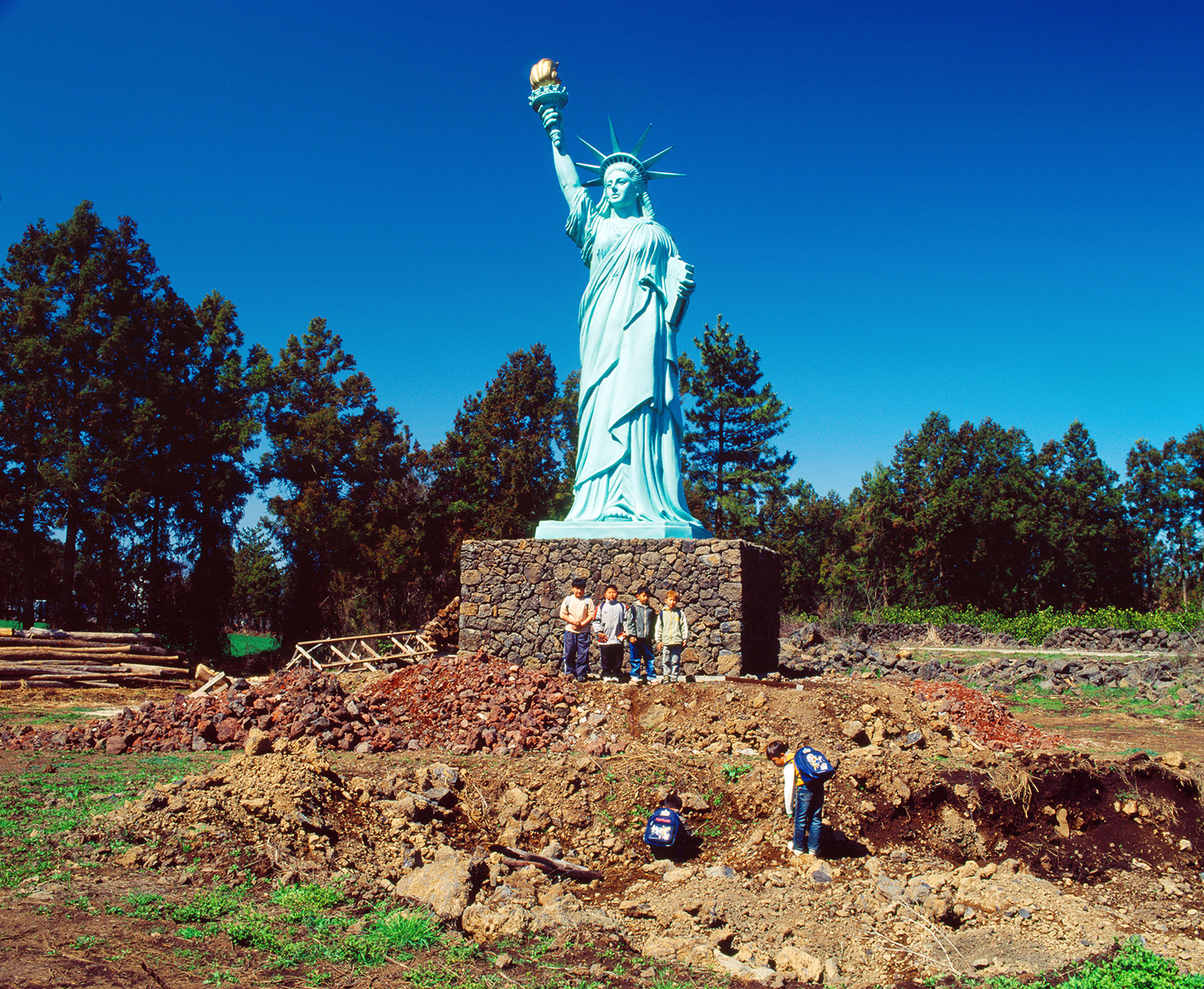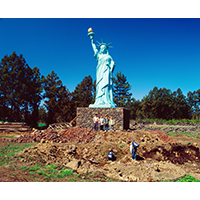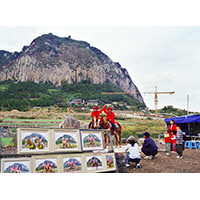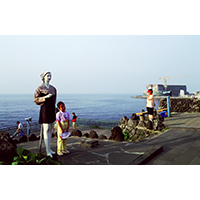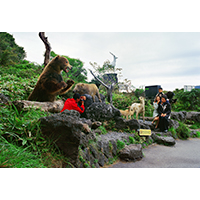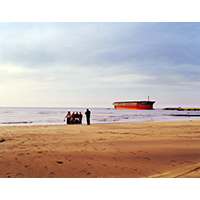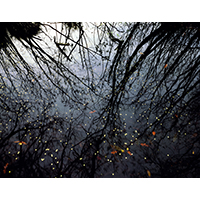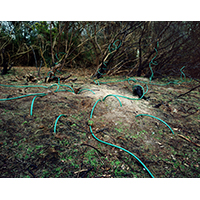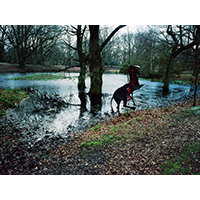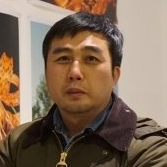
Birth
1973, Jeju, South Korea
Genre
Photography
Homepage
Interpretation of a world that leads to the world and beyond
1
According to a Blaise Pascal, “ The heart has its reasons of which reason knows nothing.” In the heart, an event occurs every day, a new space of depths is created and time passes from time immemorial. The history of greed and guilt repeats itself and a cycle of suffering and healing also repeats. That is truly ‘ one world.’ How can we get to know the world? There is a mirror that guarantees us get there – the world we live in. However, the world is a broken mirror and thus a text that requires annotation. The world does not show the path leading to the heart easily.
With sense and perception only, we cannot find the path. We need a helping hand from people who have spent their time between the world and the heart and between the realms of sense and transcendence. They could be a rabbi or priest, or a poet or visual artist though they are getting rarer. How could they obtain knowledge that leads to the heart within the world? We can find an old but still fresh way, in Hyung-geun Park’s photographs.
2
Park’s world of art does not appear to be eccentric at all. Objects were brought from the familiar living environments. Places are certainly part of the real world. The bone of herbivore or the branches of an evergreen tree squeezed out of the broken window are real and has nothing to do with a virtual or hypothetical dimension. The combination of a dead bird and wildflowers and ice-covered bare trees somewhat reflect his subjective sentiment to a certain degree. However, we cannot find any ground that goes against the conventional rules for landscape photography – until we take a step closer to and look at the objects one by one.
Park’s world of art is a world interpreted via hermeneutic approach - in an effort to get closer to truth, which is unapproachable just with a straight photograph or snap shot. As I mentioned above, the world is a text to be interpreted, where truth id hidden beneath the visible surface. Through the world without interpretation and daily life that is seen, we cannot approach the world and ‘a world beyond the world.’ Therefore, to provide people an opportunity to “ dream and vision again” – to help people go beyond the world, something is required more than the ‘separated’ camera, or something that can make the camera a hermeneutic mechanism.
Despite that, Park’s interpretation is closer to that of Emilio Betti than that of Hans-Georg Gadamer, given that his view towards the world is more like methodological tuning than philosophical deconstruction. The world is tuned rather than being denied. Although images are put together in peculiar way, the fundamental nature of the world remains firm. The dark, dreary and dreamy sentimental works rather in the direction of the aura of nature. Tension exists between nature and interpretation, and reality and utopia, and the artist wants to stay in between. Sometimes he wants to escape from the tension but cannot do so. He recognizes himself as ‘ others’ to both the world and absence of the world. He cannot belong to the world completely nor turn his back on it. In the other words, he cannot get away from his fate of indulging in the charm of the world and exploring it incessantly.
3
The world “interpreted from an aesthetic perspective” is not confined by physical space any longer. As a directed time is not bound to the chronicle, Park’s world is “tenseless(no tense).” His photographs captured nature that ‘appear to exist’ but not existent. The place is reconstructed through the ‘incomplete combination’ of dissimilar things, and time passes by from different sources instead of flowing in one direction – like a puddle of time? Memories rely on these directed ‘flowed – in things’ that have been directed. Take
This becomes clear when the artist adds a dead bird, artificial flowers, rotten fruits and stagnant water to the land. It is particularly true in
The reason why Park’s world appears to be more precise reproduction of the existing world is that his interpretation has secured a distance from the world. The flowers look fresher in contrast to the dead bird. The more unrealistic the image is directed, the more the world reveals truth, just like magical soup – the emptier it is, the fuller it gets. This is quite an intriguing paradox. Nature reveals itself more when it is natural and the world becomes more world – like. The ‘land’ is tuned through interpretation and, subsequently, becomes an open world beyond. This is how Hyung-geun Park explores the world and goes beyond it at the same time by interpreting the world.
Sang-yong Shim (Ph.D. in art history, Art critic)
War against the other within oneself
The work of Hyung Geun Park moves at the boundary where a taboo runs. Taboo in itself heads for violation by being exposed to the fore through his work. Violation discloses the boundary of order approved by society, and its unconditional norms become relativized. Violation, dissolution, or expansion of the boundary is profane and sacred at the same time. In a society which establishes order based on drawing distinctions of many categories, including the division between sacred and secular, violation of the boundary is the subject of punishment, but is worshipped in respect that it breaks through some limitation at the same time. As shamans did earlier times, contemporary artists also take both extremes of curse and worship by handling this dangerous power (taboo). After the 2011 exhibition which disclosed mystical energy of the thick forest far off the beaten track of Jeju, ‘Invisible River’ presented for this exhibition explores the DMZ border. The artist exposes unconscious level of the landscape which is near but covered. The issues related to the North and South Korean border, including DMZ are still the arena of the struggle of edged ideologies.
It is unique that his method is marvelous in treating this topic, the hottest border in a divided country lasting in the 21st century. However, he does not make an axiomatic fact blur on purpose. An artist Park makes good use of cameras of a lucid technical tool as an artist handles brushes although drawing a picture or a distortion of the fact is not his concern. Variations are given by colours, black/white reversal or adding text, but this is the minimum which anybody can recognize the process. Even the text added to the picture is extracted from phrases found there or interviews with soldiers as they are rather than the artist’s imagination. The text is not a fanciful tale like a myth or a legend but holds fast to the nature of fragment fact (history). The artist is interested to demonstrate a fictional method of a phenomenon itself which a fact works. The picture which could be the most empirical as well as fantastic seems to be the proper convention to describe this paradox.
In case of the Jeju forest where came closer unfamiliarly to the point of wondering whether that is our land, the border operated by the same ideology also appears as natural scenery which exudes a romantic and sublime atmosphere outwardly if that were not only primeval nature preserved as a natural monument but also associated with a historical event (Jeju 4.3 Incident) which caused thousands of casualties by ideological confrontations between the left and the right. The work of Hyung Geun Park tends to delete indexed characteristics of a picture, most of which meaning takes effect from an off-limits place currently present. The DMZ border concealed by barbed-wire fences is just a scene passing while people drive through the Freedom Avenue, and the public access is severely restricted. As shown in the picture of the artist Park, however, that place does not look like a military zone any longer. In a natural-paradise place preserved from damage caused by the development of human civilization thanks to off limits, soldiers assuming security mission are simply bearing ghosts or invisible foes.
Soldiers face the enemy by unseen disciplines. This is, in particular, by surveillance and observation. Soldiers are presented as individuals, not as groups in the Park’s work. An individual is the point which surveillance and disciplines exert their true power. In his [Discipline and Punish: The Birth of Prison], Michel Foucault (1926-1984) observes that power ultimately aims at individualization by producing something useful, measuring deflection, setting level, defining quality, and adjusting difference each other. People under the influence of power are inclined to be individualized far more clearly as the discipline-oriented system, power, becomes more anonymous and functional. An individual is also an image of reality fabricated by a peculiar skill of power which is named as discipline training. In a situation which the new Panopticon, the surveillance network including satellites floating in space is already built one upon another, soldiers in a peaceful landscape produce a repressive reality, covering up a real war occurring in routine.
This area at an extension of the Southern/Northern Limit Line often witnesses defection to/from North Korea. Now, the border is crossed by wild animals such as wildcats, elks and eagle-owls and litters swept from upper streams during flood. That place has a distinctive ecological topography derived from the river deposition rather than the river, constructing underwater barrages in the Han River, whereby the river where soldiers should fix their eyes is shadowy. The off-limits place looked indirectly into through the work of the artist has left traces without its true nature. The traces have now become another nature. Unseen ghosts conserve and expand their power through ideological device. It is the red color dyeing the whole picture that a beautiful and mysterious forest uncovers to be a tension zone as ever. Red contains the artist’s experience as a search party during the military life. The scenery tinged with red is a viewpoint of a monitor (a night vision goggle). In a ‘Redscape’ series started from 2009, seen is the bush, a mound like a mud flat, weeds under a bridge pier, the forest with puddles, heaps of earth floating like islets and woods sitting on trash.
Soldiers to guide/watch the artist taking pictures in the restricted area are also shown, who appear to be alien to the work, making the landscape far more dreamlike. Those who gaze at somewhere, standing among leafless trees, who doze off, sitting in a thicket in camouflage fatigues, and who look out into the distance behind a sparsely wooded grove perform their official duties regulated by the nation although it is unclear why they ought to be there. Those who keep watch know that they themselves are being watched as well. It has nothing to do with them whatever subjects and objects are. It is definitely impressed on their every movement and their notion through military training. Though it started from collective compulsion, disciplines internalized as the method of discipline and training to provoke automatic obedience control perspectives, behaviors and imagination. Landscape and people are locked in an invisible frame. Michel Foucault points out some kind of closure in disciplines. These requires specifying a place where is heterogeneous to everyone and shut on their own.
It is the place protected by monotonous disciplines. Disciplines are operated by authority, but the nature of authority has been shifted in modern times. Foucault observes that traditionally power is seen, flaunts itself, shows itself, and discovers the principle of power from activities demonstrating it paradoxically whereas discipline-oriented authority of modern times is exercised as invisible itself. Rather, power assigns those who obey the principle of mandatory visibility. People who should be seen in disciplines are those who obey. Exposing them in light, established is power control exerted on them. Maintaining an individual, the object of disciplines, in subordination is continuously seen and can be seen at all times. Recently, Park went there to take pictures not as a soldier but as an artist, which the viewpoint of search and reconnaissance still remains. What actually disappeared from the relations between seeing and being seen is something which makes such an interactive eye-watch possible.
The war which separated each other breaks out now in various sites beyond a certain physical realm. In a series of ‘Invisible River’ which combines landscape and text, the vast land and sky found by the artist stretches out like a landscape painting of romanticism. As seeing it in practice, the place is just woods and fields rather than the borderland full of tension. It is more peaceful and quieter than common woods. The work totally betrays the audience’s expectation that the text on a transcendental and sublime landscape would be a beautiful lyric. There included are the statements for invisible enemies, including ‘Welcome to your defection to South Korea!’ It is explored that some dialogues with soldiers shown in the work contain a self-deprecating story that ‘to be honest, as the river is not seen and defending the unseen river is our main duty, what this place is indeed…’ At the moment when the eyes soaked in the picturesque scenery recognize the letters, the romantic place is estranged. The landscape filled with mystery to the end of the vanishing point plunges into a concrete reality on earth.
Lines and language which do not exist in nature suggest a sense of a rudder to infinite space. As a vast landscape does not really fit in with words, neither do nature and history. The text is installed, printing it on the picture or on a clear glass panel to make the shadow of its letters reach the picture underlaid below. Nature throws man-made things on its surface gently like the sea eliminates the wake of passing ships. A series of ‘Tricolor’ produced by inserting in filter in front of the film as the first color photo mode is an unusual landscape with negative/positive, night/day, and up/down overturned. A surveillant’s eyes reverse everything into abnormal. Landscape bound for the Freedom Avenue and the sound which dialogues with soldiers come into hearing such as multiple episodes relating to barbed-wire fences help understand an overturned world of its own. Series of ‘Redscape’ and ‘Invisible River’ leave out structures of military camps like weapons, barbed-wire fences and sentry posts as much as possible, but make space stand out.
It implicates something which does not exist but is not non-existing. For example, ideology or false consciousness stamped in a human’s soft brain exists and does not exist simultaneously. Decades after the war, Park’s approach to the landscape of division describes the substance like a ghost as something invisible but ubiquitous which does not carry out hostility using force of arms but jumping out when time comes. This compresses the Korean situation itself. A true role of confrontation is to crackdown on the inside of the system. Society makes a scapegoat for the unity of the inside. ‘A commie’ is that in the society of South Korea, for instance. In his [Violence and the Sacred], Rene Girard (1954-) argues that a war against a foreign country and its attendant suggestion spectacular more or less has an essential function to maintain balance and stability of the society by overcoming danger of inner violence, discussing, committing, or sometimes instigating violence openly.
A future fantasy fiction, [Nineteen Eighty-Four] by George Orwell (1903-1950) represents that the rulers of two ultra dictatorships make a decision to continue conflicts between the two in order to make it possible rule over the people deceived by them. Inner stability is sustained by continuous war against the outside. To interpret the situation between North and South Korea in the logic of sacrifice, a war is to keep and reinforce a certain cultural order, which goal is to maintain the status quo. It relies on a model of cultural settlement and stabilization, unanimous violence against victims. Frustrated violence always looks for substitute victim, and finally makes it. Violence concentrated on victim causes order and sanctity, which depend upon some taboo and its violation. The Freedom Avenue nearby is the place to pass through only while it is prohibited to stand and is seen but not allowed to go. It is ‘seen but invisible’ and ‘the landscape which is always gazed but not seen’, as the artist says. Besides, it is the landscape ‘which is not a special place but widespread in daily life.’
The artist Park switches a macroscopic history of the reality of national division into a microscopic one. His landscape is naturalized with microscopic histories piled up on top of each other. He treats history aesthetically. It is a result that a concept or even reality is approached at the sensational level, and his way of ‘making it join to see what an artist sees (has seen)’ is the best reflection of reality which the artist can do. Park’s landscape embodies the reality of division which could be a hot political issue although it is neither exposure nor accusation. It is related to actual reality rather than a disposition of the artist. Microscopic strategies are needed since the reality of division is far away or deeply sank. For more than 60 years after the battlefield of the Cold War of world powers such as America and China has been finished a tentative ceasefire, incidents to feel the division occurred rarely, which stinks of ideological manipulation. Though the land of taboo on which the artist sets foot with a camera is incorporated into natural history not history, its fragmentary traces awaken history. Apparitional soldiers who keep watch for invisible enemies and are kept under guard for themselves indicate ubiquitousness of the front in a daily routine.
Surveillance is operated by disciplines and punishment. The work has no night scene due to disciplines applied to the artist. ‘Invisible River’ is a continuation of career which he has pursued on the land of taboo. As a member of a search party during the military service, he is not free from watching eyes. United with education or training, surveillance is organized into diverse, automatic and anonymous power. The approach of Hyung Geun Park to the landscape of division is ‘the new microscopic physics of power’ (Foucault) which has neither friend nor foe. Control over body by power dynamics defined by Foucault is achieved by all rules of optics and dynamics, and all actions of space, line, curtain, bundle and ratio does not appeal to aggressive acts, strength or violence. This power makes them monitor invisible enemies and themselves kept under guard, and precise technological rationality is given in this process. The authority pushing standardization enforces homogeneity. An invisible war never ends as to North and South Korea which do not look upon each other as the other within themselves. Park’s heterogeneous landscape reveals the existence of the other, deconstructing the conventional narrative about the reality of national division
Sun Young Lee (Art Critic.)
Forest obscura
Where we stand is a forest. What fills most of the space covered with dense leaves and branches is ‘solid darkness.’ The light from outside shines through, penetrating into the silence of the dark forest. The holes of the light appear to be stars spreading across the night sky. The outside is a daytime world brimmed with sunlight, but here is a domain of the inside where the light does not reach. Hyunggeun Park’s work illustrates the dark sky filled with stars as if they poured down their lights upon earth right away. In fact, however, the starlights represent the hue of the sky that one looks up from the floor of the forest. that records the numerous small particles of the light shining into the forest leads to two thoughts. First, the tiny dots of light in the sky passing between leaves appear to be stars floating in the dark universe.
Second, the cosmos encompasses not only a physical universe but also a metaphysical, religious, mythical universe. In the former case, the cosmos is confined to its image projected only at night - in other words, the dark space and a collection of planets illuminating in it. However, the latter includes all associated and analogical forms that we know about the cosmos. The darkness of the forest is similar to an abysmal depth of the universe, and sunlight shining through leaves resembles starlight. Similarity occupies most of the cosmos.
‘Forest’ takes a special position in Park‘s artwork. It is the most frequent theme in his large-scale photographs that have been produced in earnest since 2003. In his work, the forest is usually a place of trees with dense foliage. and among his series involve unknown empty spaces existing between the colonies of plants gushing out the energy of midsummer. There is an old ball buoying in the middle of a pond covered with green algae as if it had been a long time since people visited. Or, red dirt spurts out of a hole that looks like an animals’ cave hidden by bushes. The forest surrounding these scenes is dark, deep green. Besides, the dim light of dawn or late afternoon is added, making the tone of the frame sharp blue. The dark forest and an empty space within it. And time when light disappears. The interesting thing in the artist’s photographs is to see how the three factors characterizing time and space make variations.
The series is called ‘Forbidden Forest.’ The audience can understand the darkness of the forest through the theme ‘a forest where no one is allowed to enter.’ The place that the photographs show is ‘the inside.’ The space can be even called ‘the inside of the inside,’ which is intimate and closed from the outside. In this place that is isolated from the outside, or what you might call a ‘sanctuary,’ faint light reaches from the outside only enough to recognize objects. Then, even that light fades and disappears into the darkness. What is ‘the inside’? Where does it come from? We can think of two ‘insides.’ First, Michel Foucault poses a question about ‘inside (dedans)’ in a conversation on Deleuze’s ‘fold (pli)’: “Is there an inside deeper than any internal world, like the outside exists farther than any external world?” He answers to his own question: “They are not something other than the outside, but precisely the inside of the outside (le dedans du dehors).” To Deleuze, the outside is where thoughts come from. And if there is an inside of the outside, it is something that has not or cannot be thought - unthought (l’impensé). It exists at the center of thinking, as the impossibility of thinking that double and expands the outside.” 1) Second, the inside of Spinoza’s ‘monad.’ Its inside is blocked from the external light so that it is filled with absolute darkness. And yet, light appears from its absolute depth. A number of particles making up the infinite light create stains inside that reflect an external world. The particles of light dimly illuminate things far from the monad, while brightening things closer to the monad. The light serves as a means for an individual to create a self-centered world inside of it. 2) Therefore, darkness existing inside the monad is a ‘sanctuary’ that enables its individuality. These two examples indicate how darkness and scattered lights inside it appear to the individual as a text of the world.
Hyunggeun Park’s photographs clarify the fact that lights are scattered above the darkness, not that darkness remains where bright light does not reach. In most of his works of art, solid black covers a wider part of the frame. This black color presents the reason why he has taken pictures at dawn or daybreak early on. The color plays several significant roles in his artwork. First, it guarantees a high level of sharpness despite a low level of brightness of the frame. In the case of landscape pictures mostly covered with darkness and dim light, what makes deep blue tones and details clear are the shadows of black trees and rocks. The case in point: series. Second, the black color makes a conceptual division of the frame.
As in his 2009 works such as and , the dark space makes an unrealistic spatial parallel. In , the shades of tree branches cast on a curtain by the window and the wall generate the incompatible stains of light, but what makes this unreasonable scene noticeable is the darkness encircling them. The same goes for . What is seen inside the frame of the mirror is not the reflection of light, but exterior landscape that is more vivid than the interior outside the frame. What makes this transposition possible is also the outlines of deep black. Third, the color is used as the most important dramatic device in his photographs. It not only expresses darkness, but also transforms the frame into a stage. The starkest instance can be found in series. The pictures show rocks on the seashore and sea water in between at the lower end of the frame. The two-third top part is painted with black. This describes the deep darkness of the sea at night, but what we can actually see is only the flat black surface. By naming it , the artist clearly indicates that the black surface is outside of the edge. This appears to be ‘the outside’ of the world - the groundless depth of thoughts. On the contrary, the rocks in front are exposed to glaring light in an unrealistic manner like the props of a simple stage. The audience stands at the edge of the bottomless sea at night. The space of the endless ocean in this series becomes ‘the inside’ of conceptual thinking through the color of black. Looking at this color lets you remind of the traces of its implications. The absolute darkness turns into a thin layer of black.
In Park’s photographs, dramatic presentation (mise-en-scène) is often made. Sometimes, this is done through objects within the frame, pigments or the artist himself who performs (acting). Furthermore, the active transformation of pictures is made through Photoshop or Retouching. How to accept the denial of photographic purity can serve as a significant clue to understanding his works of art. To the artist, realistic factuality enabled by large pictures seems to be one of several conditions only for photographic narratives. Photographs can be presented in themselves, but also be modified if necessary. For this reason, the artist intends to represent, for example, several moons hanging above the horizon of the dark sea in and sunlight shining between leaves that looks like starlight in .
The problem of photography is its ‘immobility.’ As it is composed of a single frame, its way of existence should be handled within the frame. In this regard, all representations are frozen in this single moment unlike plays or films. That is why the factuality of photography becomes the reason for its existence (raison-d’être). Photographs record things that actually existed at that very moment. R. Barthes once said that there was ‘no future’ in photography. In other words, it does not give a chance to modify what it presents. Everything is completed in the way it is shown in photographs. He lamented about photography, citing ‘the dead play on death (le théâtre mort de la Mort)’ because self-completeness of every photographs, or the immobilization of time (l’immobilisation du Temp), leads to the absence of consequences (l’absence de conséquence). 3) As Jean-Marie Scheffer pointed out, photographs are buoying somewhere. They freeze a moment in time, for which we do not know where it comes from or where it is heading. 4) By contrast, the precariousness and immobility of photography make it a spector as exceptional images. Unlike film images that resemble reality, photography takes root as a form of memories in our head.
Hyunggeun Park’s photographs intervene in the form of memories. They are immobile, but constantly imply some consequences. We can find mprecise but fixed, far and thus detail-missing, and very real-feeling memories in our ‘dreams.’ The irony revealed by his artwork is that photography makes it a relative thing in a place where photographic factuality is maximized. His artwork suggests there is another layer, besides factuality, even in the highest-resolution photographs. The images of the forest shown in his latest series do not contain any representations, but they seem to present the concepts of forest rather than a real forest, or a forest occurring in memories. This is not irrelevant to the intention to make the tone of these pictures dark. The forest seems to disappear into the silence of the night anytime soon, which implies rest in an inescapable and eternal place like a scary dream. The immobility of photography overlaps with the concept of photographic death. This is a play, but a cruel and cold play created by photographs.
series, produced from 2007 to 2008, present the most indicative examples among Park’s works of art. In the series, the artist himself performs. Most of all, the artist took these photographs by himself using a release shutter when he was travelling in the mountains during cold winter time with a large camera. In the photographs, the artist takes certain postures by use of lighting equipment and props he prepared himself and records them. They look like pictures taken in a studio or indoors of a theater. That is because the use of lighting at night divides most of the frame into artificial light and darkness. In particular, the cable of the release shutter button shown at the center of the frame emphasizes this impression. Like an actor, the artist delivers a monumental performance within a camera angle. Indeed, this is for momentary memories, not based on the passage of time. Everything, including snowflakes falling down from the sky, descending red pedals and sparkling fireworks, is fixed in a flash for a still moment. Even the moon in the sky is borrowed, in part, to describe transience through momentary flashing effects of a reflector and lighting equipment the artist holds. It is not clear what to commemorate through these pictures. Maybe that is the aspect of time defined by a shutter-pressing moment by the artist, or a photograph. This is also the moment when the artist enters a world of afterimage reflected inside the camera obscura.
The moon frequently appears in Park’s photographs. Besides and in series as well as in series, even the round reflector placed between trees in and the satellite dish in suggest the moon in the dark sky. It is not certain if the shimmering light in the sky in is the sun or the moon. This bright and round circle floating in the dark space is adopted as a sign of transcending time and space of photography. The moon indicates the exterior of the forest. This sign traversing the perpetuality and universality of time and the boundary between exteriority and interiority appears in the frame as a whole view, in the interior of the forest and on the surface of photographs in his artwork. The moon is also used as another metaphor.
For the hole, snow, light, face and the immobility and perpetuality of time in his photographs. It is a transcendent sign indicating that the stage is linked with the world in a momentary drama that the artist produces.The forest and its outside are spaces to replace the inside and outside of the artist, audiences and photographs. There are small spaces within the forest, where grass, soil, small stones and water exist. All of them come from within darkness. What the forest represents through them is the aspect of the world. The existence of the world is recognized through things floating in the air. Snowflakes are falling down from the sky. While they are covering the world, photographs commemorate their memories. Everything is photographic. The darkness of the world resembles that of photography. Hyunggeun Park’s works show events taking place somewhere between the two worlds.
Jin-Sang Yoo (Kaywon School of Art & Design Professor.)
A Return to the Time and Place Where the Outset of One’s Self Began
Hyunggeun Park returns to Jeju with a solo exhibition, “Voyage of Memories,” presenting a good number of his photo arts to his hometown, Jeju, where he grew up and spent his youth. To the artist Park, Jeju is far beyond a simple hometown. It is a never-drying spring that constantly fills his emotions and feelings. His works capture the affluence of Nature and emphasize the details, creating a dreamlike or exotic mood. But actually, the natural objects in his photos are all connected to their roots where the beginnings were initiated. A hometown is natural to him like inhaling and exhaling. But returning to the hometown is a separation from familiarity in order to head towards the unknown. ‘Memories’ in the “Voyage of Memories,” is not a re-creation of personal reminiscences or episodes. The memories span from the beginning when the ground and water were formed in the time zone in which all vestiges of mankind will be erased.
The stage of his work is the universe which was there before he was born and will exist after he is gone from this life. The scope of space and time that he zooms in is wide and deep. Returning is not an issue of going against the stream of the times to go back the genesis. Instead, it is caused by each renewed incidental happening. Navigating is not simply following a pre-set route directed by coordinates. Rather, it is an aimless drifting like dreaming a dream or recalling memories. Drifting is a process that enlarges a surface on which meanings are created. Although drifting seems aimless and visionless, its center point does exist, directing to the very moment and place where the beginning of one’s body and the space and time commenced.
In his work “Forbidden Forest (2009-2011),” for the commemoratory exhibition, for winning a ‘Daum Artist Prize,’ he practiced austerity by giving less of artistic staging or subjective intervention. He showed the true facets of Nature that he met in the entire screen by adopting a panoramic format. Because it is photography, the moment of meeting an object is particularly special. It is not a burial as an object or restoration becoming a subject. In photos, it is a phenomenal meeting, as if the object and the subject are tightly clenched with each other. The mystique filled in the photos came from the experience that one becomes oneness with Nature. It is based on the organic outlook of the world in which micro particles and gigantic beings maintain a mutually depending relationship weaving a fine mesh net. The same mystic mood also seeks to emit the intrinsic power of Nature i.e., the heterogeneous and impenetrable force. The Nature in his universe elicits the feelings of relief and a shiver of natural awe, beauty and sublimity, simultaneously. Classicism and romanticism are also detected there, as well.
In contrast, his “Untitled” series are symbolic while the “Tenseless” series are surrealistic. However, it is difficult to clearly determine his works as one of the schools or ‘-isms.' The “Cosmos (2010)” is a sky looked up at while lying down in a forest. It looks like a night sky interspersed with a number of stars of the Milky Way, in outer space. As the wind blew, the aged forest let the rays of light shine down through the interstices of the densely covered leaves. An illusory scene was created. The irregular ruptures tearing the black veil let viewers leap and move to another dimension. A broad daylight is turned into a pitch-black night. A forest is transformed into a cosmos. It is not an artificial fabrication but a moment of a miraculous meeting with continuing reverberations from corresponding with Nature.
Looking at the scattering rays like the stars in the Milky Way, makes viewers think of themselves as one element of the great universe and a grain of sand at the beach. By capturing a moment of the swaying universe, the photo artist Park, lets us know that Nature itself, as a whole, is art. Nevertheless, the moment that Nature becomes art does not visit at anytime or to anyone. It is given to an artist who waits for a long time, to be there at the meeting when eternity and the transient moment get together. The photo, “Forbidden Forest (2010),” was taken in a forest hundreds of years old with a suggestive purpose for the wellbeing of a community. Like a living fossil, the photo has the sacred energy that may be found only in an antiquated place. Park’s photos focus on restoring wildness in different places. The dark green tone of the thick forest is the unique vegetation inhabiting in the lava soil. The trajectory of Nature’s energy that flowed in and swirled around the forest for million years, is completely preserved. There is no vestige of the human touch in this ‘Forbidden Forest,’ but there must be someone who found this place and worked to keep the forbidden forest as it is. The “On the Edge (2010-2011),” is a series of long screen photos connected like a folding screen. With a dark background, only the planet-surface, like the ground, gives a clear reflection. A unique view of the lava covered coastal area on Jeju is transformed into a scene with rocks in a variety of shapes. Without any addition or omission, this familiar place soon appears as a strange planet, a deep seascape, or a piece of oriental painting in an antiquated picture book.
His preferred Nature is a place where the texture and the touch of the sediments that fell in layers can be lively felt. His recent photos, composed of panoramic moments, have less of the artificial staging. That does not mean that they are not mere dry pictures of some objective articles. He wants to revitalize the Nature’s primitiveness that either disappeared by the prevalence of the mechanical civilization, or has been domesticated changing its appearance into a more humanized one. In his efforts, there exists not only the unique shape of Nature but also the energy of Nature. The energy of Nature holds diverse states and levels of strength, from the old and archaic to a newly emerging type of energy. The meeting and parting of different energies make the Nature in his photos appear as a dream stage to emit his poetic sentiment and unconsciousness. The “Untitled” series, completed between 2003 and 2004, portray aesthetic scenery with light touch of colors added to the layers of an artificially built Nature, like a park. Colors in his photo works function as a dramatic element that creates differences in mediocrity while making the latent elements of scenery to be exposed explicitly. The added colors suddenly change the original scenery into a different scene. The stagnated red water inside the forest looks like an inner flesh of Nature, while a mystic veil is drawn on the other side of the forest, where flower petals are laid on the heap of fallen leaves. The bright-colored flower petals scattered on the surface of a pond, and the leafless trees reflected on the water, draw one’s eyes to the surface of its abyss.
The "Tenseless” series, were completed from 2004 to 2008. Hyunggeun Park tries to tell an unnamed story by setting small objects, either naturally obtained or artificially created, arrayed on the side of an old wall or in the deserted ruins. On the contrary, the elements of a causal relationship, to include, who, when, and why, are endlessly stretched out. A ball floating on the green swamp, small cherries dropped down near the old wall, red wires falling down inside a burnt blackened building, spilled paint outside the door that connects to the forest, a wall with a thunder-like crack, frozen butterfly wings in the winter mountain covered by snow flowers, conversations of crawls in a winter night: all of the portrayed scenes have a common characteristic, i.e., the unexpected wildness. They are all a small incident that took place behind the stage that the photo artist created, but their meanings are open for interpretation. The stage is deep and the main character does not exist, while the direction the incident would process is opaque. His photos are not to be read with a precise meaning. They appeal to emotional sentiment which is not something that simply begins with vagueness and ends with ambiguity. As it was pointed by the French philosopher Maurice Merleau-Ponty, the emotional sentiment can be defined as ‘a potential that can be self-evident in silence and a potential to become tacitly meaningful.’In the “Tenseless” series, produced in the period from 2008 to 2011, the time zones that cannot cross each other and the scenes that belong to them are put together in a long trail. The “Tensless-62, Night and Day (2009),”captures incidents that occurred in a natural environment where it is not distinguishable whether it is day or night. In the “Tensless-63, Fade Away” (2009), the afterglow of the sunset and the blowing curtains melding with each other evokes a sense of loss.
The height and the strength of waves of the incidents are not objective. The “Tenseless-65, Last Summer (2009),” presents beautiful but pathetic evidence of the incidents, through a grassy path stretched along the bush in the forest under the deep and blue sky, and the scattered flower petals that look like pieces of red flesh or splatters of blood. The surroundings are dreary and chill-breaking as if in a deep sea. The atmosphere is the projection of the sentiment and the coming journey of the artist, who has to take and make a pathless path. In the “Tenseless-70, The Cave (2011),” Hyunggeun Park, transforms a sculpture of Nature, that took countless years to create, into a shrine of Nature showing a cave with hanging icicles and geometrical patterns on the floor. The “Voyage (2007-2008)” series, which shares the same name as this exhibition, is featured by the juxtaposition with poetic and dramatic arrangements of object articles in the natural environment. Like another one of his photo works, “A Voyage-1, Full Moon (2007),” the grassy field, snow, and the moon coexist without contradiction. Meeting with Nature is a primitive incident that sets off the beginning of Hyunggeun Park’s photos. Although the perspective of Nature, in his mind, well preserves the characteristics unique to a particular place, such as, the parks that he saw during his study in the U. K. and the landscape scenery of his hometown, Jeju Island, he also weighs in with his own artistic colors. It is not the way that the subject body is absorbed by the visible object, or the visible object comes into the body of the subject. The subject body meets the object body while they still retain their differences. As Merleau-Ponty said that a meeting causes an exchange between the world and “I,” the subject body. The meeting is also an exchange between the perceived objects. Perception opens a door to the world. That is how an emotional object can let the subject body enter (connect to) the world.
In such a context, the world is an outlook about the world. In his photo works, the visible objects are fully charged with invisible objects and vice versus. Merleau-Ponty discusses the visible and the invisible in his manuscript, “The Visible and the Invisible.” The visible demands the invisible. ‘The same (le meme) demands ‘the others’ (l’autre)’. According to Merleau-Ponty, the outset of the other’s sight is not at a particular point of a space. The other is born from the side where “I,” the subject body stays and by fission. The other does not settle down anywhere. The other is everywhere and anywhere in the surroundings by which “I,” the subject body is enclosed and omnipresent, like the beings in a dream or mythical beings.
In the works of Hyunggeun Park, the binary opposites, like the same and the other, do not compromise easily or stay in a suspended mode. His photos stage the mysterious solitude of Nature as a background for an unnamed incident to take place. Tensions surge between the differences in the incidents and explode instantly. The moment of bliss (jouissance) exists. As it is the same in everyday life or science, if Nature is taken as the means for labor or to acquire cognizance, the state of bliss can never be reached. The other will take the possession of the place of bliss. The restored wildness of Nature and art in his photos makes it clear that, as it could be the ultimate insignia inscribed not in the body of the subject, but the bodies of others, the other surely exists at the current time. The voyage of Hyunggeun Park is not a return to a settlement in his ego or subject body or his hometown. It is another voyage, and a challenge to explore another different world.
Lee Seon-Yeong
Lucid Review for an Aesthetic Soul
I look at my photographs in Certain People differently from others. I cannot see my photographs with desire in my mind and have fantasies about people in them. Eros of photographs, which identifies subject with surface, stops. What I feel is the gap between me and the image. My photograph that Robert Mapplethorpe took did not look like me. The gaze was made for the camera shot. That is a result of compromise that was made unstably between an effort to cooperate with my best friend and photographer and an endeavor to keep my dignity. I doubt that my work appears to be the photograph Mapplethorpe took. Or I doubt if this would look the same with my picture that he will take next time. – Certain Mapplethorpes, 『Where the stress falls』 by Susan Sontag
There are harmless photographs that shock me inside. “Harmless” here does not mean that it would not offer inconvenience or tension. This harmless shock originates from Hyung-Geun Park’s preference for the rapture of images. Nietzsche said that art completes nature in a metaphysical way, which suggests that his work makes up nature in a sensual and aesthetic manner. His photographs are peculiar in that they are full of images that arouse and restrain emotions at the same time. His landscape is not involved in comfortable and calm images or strange or tense images. His work consists of images that can be interpreted from a neutral and transparent perspective.
Profane Illumination & Gazing Subject
As French Photographer Eugene Atget visited a same place regularly with a few year intervals and took pictures of same buildings from different angles, Hyung-Geun Park takes photographs in a place whenever he visits again and again for a long period of time. That is because photography is not about capturing a moment but about delaying time forever like an actress in Japanese traditional play, Noh, drags her long skirt. Perhaps for the artist, selecting a subject is not just discovery. Rather, it is an incidental event and a chance to encounter his old soul. Taking a photograph is to capture the momentum, not a moment. In this regard, the momentum implies ‘the everlasting or aged moment.’ In this exhibition, Hyung-Geun Park continues his soul-searching pilgrimage with steady passion and a spirit of adventure in pursuit of an existential and aesthetic pleasure.
His photographs offer an opportunity to recognize something new and astonishing out of common, trivial, old and incidental things like German Philosopher Walter Benjamin’s concept of “Profane Erleuchtung (Profane Illumination).” Besides, trance experience is closely involved, which appears to be in contrast to the former at a glance. A butterfly on a snowy branch, a peacock in an artificial lake, a paper castle in the snow-white environment and several moons over the ocean are the unusual combinations that can be seen in daily life. These groupings, however, are not a strange method for modern artists any more. Rather, they are frequently used these days.
Nonetheless, his pattern is not a mixture of active images but a combination of feeble and trivial images. In other words, he destructs the boundary between nature and culture by making the distinction between natural and man-made production blurred. But the artist did not seem to intend to produce the images on the edge outright. That is probably why his images are vague like a dream and transparent like a movie, which insinuates that the codes or components of images are buoyant without conveying any meaning. But those images appeal to us intensely like a film with clear images. The buoyant codes means that signs do not match with meanings – simply to put it as ‘meaningless’ or ‘irrecognizable.’ This also indicates the meanings that are not codified and a more possibility of perception.
In this regard, his works resemble surrealistic photographs that show a dream with an unsettled meaning or an unconscious world. That is a world beyond reality, an improbable world or a world with surreal images. The artist, like other surrealists, aims to turn reality into a magnetic field of dream and to sublimate it to poésie (poetry).
It is impossible to create these unreal images without momentary absorption of time and space. This power puts his landscape series in the still secretive and meaningless range. Moreover, this can be explained by the concept – the momentum of “a gazing subject” that French psychoanalyst Jacques Lacan and phenomenological philosopher Maurice Merleau-Ponty elucidated, with Paul Cezanne’s remark in mind that the scenery in my painting reflects on itself inside me. Only this way does a landscape photograph go beyond the clichés, surfacing as a living creature with an unsubstantial body.
From Self-absorption & Desire To Contemplation & Meditation
Hyung-Geun Park has been undergoing a transformation in terms of artistic intention and style since he came back home from England. His previous works were vastly pictorial. In modern art, it is commonplace that photographers imitate painters and vice versa. In this respect, what his works are pictorial means a glut of images through tactile factors and colorful delight. This excess represents ‘punctum’ or an ontological and psychological tone. Likewise, his earlier works are interspersed with the images that are immersed in subjects – in other words, the Unity of Self and Object. The artist became a practical performer of a sort of ‘uniting with an object.’ Thus, he turns into a landscape, a forest and a pool. In turn, the scenery becomes sensuality, body and a layer of fetish. The landscape that he produced has finally served as an aberrant and compulsory pictorial photograph that completes the human shortcomings, beyond a scenery picture.
While his previous works were the images that directly evoke emotions, this series is a collection of images that slowly exclude feelings. In other words, his past photographs were synesthetical, visual, tactual and auditory means to appeal to emotions straightforwardly. By contrast, this series is more down-to-earth, cautious and ascetic. At the same time, it is less impressive, decorative and energetic. His previous works had narcissistic images that provoke empathy, whereas his recent photographs are intellectual, aloof, and thus thought-provoking. Contemplative art induces the audience to have a certain amount of control, so it is no less than an art that encourages people to delay instant satisfaction.
While his past pictures delivered the images of excess by providing an eccentric spectacle or abundant spectacular views, his latest job was to put a priority to balance through internal factors such as spacing, carelessness and contemplation by offering more space and scarcity. Furthermore, in his older works symbolism and allegory were employed in order to add the sensual factor to nature and therefore to create man-made and artificial beauty. On the contrary, this time he seemed to generate images that appear to be devastating and dry, but simple and permanent, rather than to focus on sensual pleasure. Which of these images would bring in a more fantastic energy?
Becoming Others & Numerous Double Gores
A man who is lying on the lawn on a snowy day in summer. A man who looks like a boy, holding a mobile made of small transparent fishbowls. A child-like man who is standing an artificial moon in broad daylight. A man who is facing bands of light beside deserted flowers. A man who is standing in snow with a bird cage in his hand. A man who is sitting alone next to a road. Actually men, not a man. A man is not enough. The men are the artist’s alter ego (the other I) – double gores.
His self-portraits make the audience feel anxious. Where does this strange and awkward feeling come from? His self-portraits are far from other conventional ones. These photographs appear that they would not tell about the artist at all. In addition, they are different because he does not stare at the lens in any pictures. It was set that people would not notice that all people in the photographs are actually one person – the artist himself. But the audience feel uneasy in front of the photographs, not because of these factors. The impression might come from that artist is a subject – a sort of “objet.” But that is not all. Probably he was so conscious about the camera and the communication between him and the camera took place superficially. In other words, the subject to take pictures transformed to the object itself. It appears that the unity of subject and object – gazing – did not happen. Is it an exaggeration to say that this carelessness and avoidance dilute his existential belief as an artist?
Nonetheless, his self-portrait looks like a well staged and framed screen in which possibility and contingency was ruled out completely. In contrast to his previous works, he turned his back on the camera (lens) instead of gazing in his recent portraits. Moreover, that a cable connects the photograph and the scene outside contributes to expanding the angles for the external scene. That the artist does not pursue a complete screen seems to have a strategic purpose to help notice more things.
Together with other objects, his portraits are to realize his own utopia, not simply representing the real world. For example, the artist communicates with nature by listening to the sound of the Earth. And he pursues the dialectic truth of emptying and filling with a mobile of fishbowls in his hand. Moreover, he dreams and yearns for an eternal world as seen in the photograph of a boy holding the artificial moon (light) in broad daylight. All of these show that his self-portrait series do not convey simple philosophical messages. That is, he is not only making utmost effort not to lose a sense for existence as an artist but expressing his longing for utopia and nostalgia for nature as a dreamer.
This is not to say that discomfort from his works was reduced to some extent. The artist might have intended to make his audience feel nervous from the existential perspective. The existence as an artist is like posing constant questions that do not or cannot have perfect answers – just like Sisyphus in Greek Mythology.
On the Border between Concealment and Unconcealment
I sometimes feel strange that unnecessary beings are still floating around in his work. I was wondering what kind these photographs would be if these ornamental elements or episodes (not necessary components) were abandoned during whole time of my writing – whether such simple and refined images could represent any aspect of the authenticity of art that has been hidden so far. So I reflect on the comparison made by Susan Sontag. Jean Cocteau and Robert Bresson had common traits that both of them produced images in ‘Spiritual Style.’ Although Cocteau was a witty romanticist who was attracted by physical beauty, he always adorned himself with artificial frills. Bresson’s emotional quality was anti-romantic and solemn to move away from artificiality that helps keep and develop an extravagant pleasure – physical beauty. ('Spiritual Style in the Films of Robert Bresson', Against Interpretation)
Ultimately, if the way to reveal truth in artwork is escaping from concealment, then more things should be disclosed under the condition of cover-up. In this regard, Hyung-Geun Park’s recent artwork takes a monotonous form by excluding emotional elements and thus the response to objects was delayed. Even this could be a methodology to bring to light the truth that is based on strong aesthetical pleasure, but it is questionable if it is obvious in his works. Therefore, this exhibition mirrors his contradiction and confusion in the transitional stage. For now, any complacent compliment would not help him do his job. It would rather be right to say at this stage that you look forward to seeing his works in progress.
Kyung Hee Yoo (Art Critic/Ph.D.)






